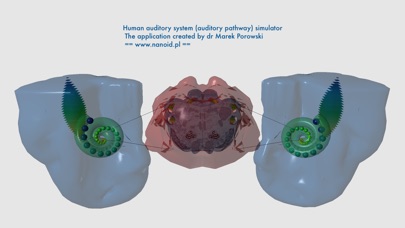
Auditory System Simulator app for iPhone and iPad
Developer: Marek Porowski
First release : 11 Mar 2018
App size: 32.91 Mb
Auditory System Simulator.
The purpose of the app was to show the scheme of the auditory pathway, its tonotopic organization, and function. The app shows anatomical structures of the brain involved in the processing of hearing information. It shows classic ascending pathway from the cochlea to the superior temporal gyrus where the primary auditory cortex is located. Every structure visualized in the application has a short description with most important information about it.
What is really interesting about the app, you can visualize the flow of the information in real time: the input from the microphone is divided into several frequency ranges. Then the amplitude of given range is mapped to the region of the cochlea that is responsible for the process of converting energy: you can observe high frequencies in the basal turn of the cochlea as the blue dots, mid frequencies as the green dots and low frequencies in apical turn as the red dots. The signal from the cochlea is then directed to the deeper brain structures and finally reach auditory cortex of the temporal lobe.
You can click on any visible structure thus you will get some important information about it. Some of these structures will disappear to visualize more deeply localized groups of neurons responsible for auditory processing. You can strip almost all of them and you will get only the working neuronal network. To recover initial view you can double click on the screen. You can also swipe left, right, up & down.
The application has some interesting property: behind the scenes, there is a neural network made from small building blocks that act like neurons. The auditory information excites the first neuron in the cochlea, and if it exceeds its resting potential, then the next connected neuron is stimulated. Furthermore, each neuron is working in its thread, being the independent unit, like in real world. It means that the app is demanding in terms of CPU & memory use. It was a bit of an exaggeration to include the neuronal network in this very application but I wanted to test it in the real product.
Reconstruction of the tonotopy map of the structures is not a hundred percent accurate - my intention rather was to show a general idea about the tonotopic organization of the individual levels of the auditory system than to draw a detailed functional map.
I hope the app will be interesting to some groups of people like medical students but not only. And I will appreciate any of your comments.



